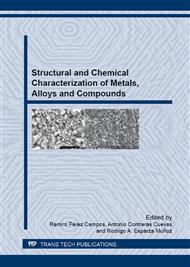[1]
D. Belitskus, Reaction of aluminum with sodium hydroxide solution as a source of hydrogen, J. Electrochem. Soc. 117 (1970) 1097-1099.
DOI: 10.1149/1.2407730
Google Scholar
[2]
M. B. Kannan, and V.S. Raja, Hydrogen embrittlement susceptibility of over aged 7010 Al-alloy, J. Mater. Sc. 41 (2006) 5495-5499.
DOI: 10.1007/s10853-006-0287-1
Google Scholar
[3]
J. Skrovan, A. Alfantazi, and T. Troczynski, Hydrogen Generation by Accelerating Aluminum Corrosion in Water with Alumina, World Acad. Sci. Eng. 55 (2011) 325-330.
Google Scholar
[4]
L. Soler, A. M. Candela, J. Macanás, M. Muñoz, J. Casado, Hydrogen generation from water and aluminum promoted by sodium stannate, Int. J. Hydrogen Energy 35 (2010) 1038-1048.
DOI: 10.1016/j.ijhydene.2009.11.065
Google Scholar
[5]
L. Soler, A. M. Candela, J. Macanás, M. Muñoz, J. Casado, Aluminum and aluminum alloys as sources of hydrogen for fuel cell applications, J. Power Sources 169 (2007) 144-149.
DOI: 10.1016/j.jpowsour.2007.01.080
Google Scholar
[6]
S. M. Momirlan and T.N. Veziroglu, The properties of hydrogen as fuel tomorrow in sustainable energy system for a cleaner planet, Int. J. Hydrogen Energy 30 (2005) 795-802.
DOI: 10.1016/j.ijhydene.2004.10.011
Google Scholar
[7]
M. Q. Bo, K. X. Li, H. Li, F. Y. Zun, Y. Z. Xun, D. M. Li, L. Y. Hong, C. L. Quan, A new method for generating hydrogen from water, Chin. Phys. Lett 25 (2008) 3482-3484.
DOI: 10.1088/0256-307x/25/9/104
Google Scholar
[8]
A. V. Parmuzina O. V. Kravchenko, Activation of aluminium metal to evolve hydrogen from water, Int. J. Hydrogen Energy 33 (2008) 3073-3076.
DOI: 10.1016/j.ijhydene.2008.02.025
Google Scholar
[9]
O.V. Kravchenko, K.N. Semenenko, B.M. Bulychev, K.B. Kalmykov, Activation of aluminum metal and its reaction with water, J. Alloys Compd. Vol. 397 (2005) 58-62.
DOI: 10.1016/j.jallcom.2004.11.065
Google Scholar
[10]
X. Chen, S. Shen, L. Guo, S. S. Mao, Semiconductor-based photocatalytic hydrogen generation, Chem. Rev. Vol. 110 (2010) 6503-6570.
DOI: 10.1021/cr1001645
Google Scholar
[11]
L. Soler, A. M. Candela, J. Macanás, M. Muñoz, J. Casado, In situ generation of hydrogen from water by aluminum corrosion in solutions of sodium aluminate, J. Power Sources 192 (2009) 21-26.
DOI: 10.1016/j.jpowsour.2008.11.009
Google Scholar
[12]
H. Z. Wang, D. Y. C. Leung, M. K. H. Leung, A review on hydrogen production using aluminum and aluminum alloys, Renew Sustain Energy Rev 13 (2009) 845-853.
DOI: 10.1016/j.rser.2008.02.009
Google Scholar
[13]
J. Macanás, L. Soler, A. M. Candela, M. Muñoz, J. Casado, Hydrogen generation by aluminum corrosion in aqueous alkaline solutions of inorganic promoters: The AlHidrox process, Energy 36 (2011) 2493-2501.
DOI: 10.1016/j.energy.2011.01.041
Google Scholar
[14]
G. L. Chen, C.T. Liu, Moisture induced environmental embrittlement of intermetallics, Int. Mater. Rev. 46 (2001) 253-270.
Google Scholar
[15]
M. Salazar, R. Pérez, and G. Rosas, Environmental embrittlement characteristics of the AlFe and AlCuFe intermetallic systems, J. New Mat. Electrochem. Systems 8 (2005) 97-100.
Google Scholar


